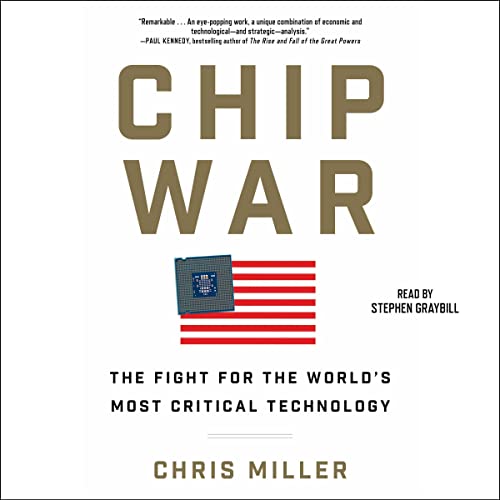Do you remember the last time you went a full day without interacting with a device powered by a microprocessor? It is becoming increasingly rare, as these tiny chips have infiltrated nearly every aspect of our lives. In “Chip War,” Chris Miller takes readers on a fascinating journey through the history of the semiconductor industry, showing how it has shaped the modern world we live in today and why it’s at the centre of a critical battle between the US and China.
In this article, I want to share my takeaway from the book by summarising the most interesting themes that stood out to me. Here are the key points that I found particularly enlightening.
The semiconductor industry has been growing exponentially since its inception in the late 1950s. This phenomenon was observed by Gordon Moore, who proposed the famous Moore’s Law which states that the number of transistors on a chip doubles every two years.
This trend has driven the cost of computing power down, expanding the use of chips in various industries.
One of the key steps in chip manufacturing is lithography, which involves projecting a pattern onto silicon to indicate where the transistors will be placed. However, as transistors have become smaller, the visible light used in lithography has become too broad, leading to the development of EUV (Extreme ultraviolet) lithography that uses smaller wavelength light in the ultraviolet spectrum.
There is only one company in the world that can produce machines that provide light at the necessary precision and scale for EUV lithography.
That is ASML Holding (Advanced Semiconductor Materials Lithography), a Dutch multinational corporation founded in 1984.
The EUV lithography machines are extremely complex and require one of the most powerful lasers ever used in a commercial device. The cost to produce each machine is $150 million, and multiple airplanes are required to transport them. However, the company heavily relies on sourcing components from other trusted suppliers. For example, the laser needed for the system comes from another company, TRUMPF. The laser has around 457,329 parts, many of which are made by different players.
Assembling such a complex machine seems almost unimaginable. Notably, ASML has engineered their supply chain process to select only trusted suppliers that can deliver high-quality products on time. The mean time to failure for each part of the machine has to be measured in decades to ensure the machine operates correctly. Achieving this level of precision and reliability has been an extraordinary challenge, and it is why only ASML can produce these machines.
Initially, the main driver of innovation in semiconductors was the US military, with the Pentagon funding early research in the field. Chips were instrumental in achieving miniaturisation, and over the Cold War, chips were used in various military devices. Now, machine learning and artificial intelligence are heavily reliant on advanced chips and pushing the industry forward.
There are only three companies in the world capable of producing cutting-edge processor chips:
- TSMC in Taiwan
- Samsung in South Korea
- Intel in the United States
TSMC is the leader of those three, producing 90% of the most advanced processors that go into smartphones, PCs, and data centres. TSMC promises never to design any chips, but only to manufacture them, and it serves many different customers, including Apple, Nvidia, AMD, and Qualcomm.
The other 10% of advanced processors are produced by Samsung of South Korea, and Intel is currently a generation or two behind what either of those firms is capable of producing.
Founded in Taiwan in 1987 by Morris Chang, TSMC was the world’s first dedicated semiconductor foundry and has long been the leading company in its field. TSMC’s birth and rise are a public-private hybrid institution. The government of Taiwan provided half the capital for the company and was very supportive of the company’s early development. The firm had to survive from day one by selling to the international market because the domestic market in Taiwan was far too small to sustain a semiconductor industry.
TSMC grew up alongside new semiconductor design firms that outsource their manufacturing to TSMC. The concentration of the semiconductor industry in the Taiwan Straits creates a point of vulnerability for the entire world, and the geopolitical situation around Taiwan has become merged with the world’s dependence on semiconductors.
For instance, a computer virus targeting TSMC could disrupt the production of various goods, including cars, smartphones, and PCs, leading to a global economic crisis.
China’s dependence on semiconductors has increased, with the country importing more chips than oil. Taiwan’s chip production is crucial for US-Taiwan relations and peace between China and Taiwan. The geopolitical situation around Taiwan has become intertwined with the world’s dependence on semiconductors, making the Taiwan Straits a “silicon shield.” However, semiconductors are not the primary reason for US and China’s interest in Taiwan, as both countries have been involved in the issue since 1949, before the invention of chips.
In case of a crisis, China is likely to lose access to the most advanced chips produced in Taiwan, also in Korea, Japan, and the United States, which is an extraordinary vulnerability.
For China’s electronics industry, moving up the value chain requires producing semiconductors. China has been spending billions of dollars a year since 2014 to try to produce cutting-edge chips domestically but remains fundamentally dependent on imported machine tools like lithography tools. So, although China is a manufacturing powerhouse, it is a small player when it comes to the production of semiconductors, especially when we’re talking about cutting-edge semiconductors.
The geopolitical situation around Taiwan has become intertwined with the world’s dependence on semiconductors, making it crucial for all stakeholders to address this vulnerability.
